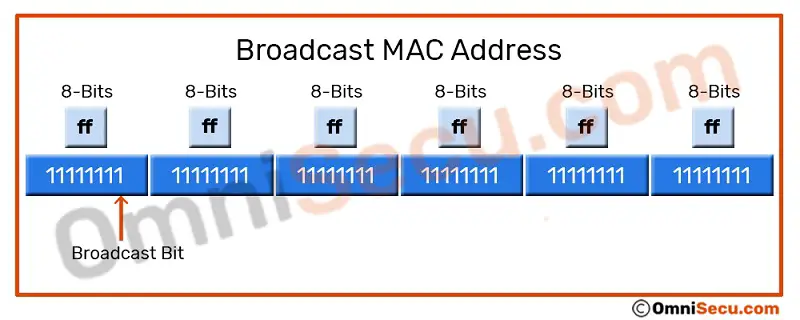Broadcast MAC Address - ff:ff:ff:ff:ff:ff
The MAC address used for broadcast (broadcast MAC address) is ff:ff:ff:ff:ff:ff. Broadcast MAC address is a MAC address consisting of all binary 1s.
Broadcast is "one to all" type of communication. In other words; "send once receive all". We have two types of broadcasts in IPv4; limited broadcast and directed broadcast.
Please visit following links to learn the difference between limited broadcast and directed broadcast.
I strongly suggest you to visit and learn below lessons before reading further about broadcast MAC Address - ff:ff:ff:ff:ff:ff.
- What is Multicast, What is Broadcast
- Binary Decimal and Hexadecimal numbers and conversions
- Five layered TCP/IP model
- Network Layer (Layer 3)
- TCP/IP Data Encapsulation and Decapsulation
- Datalink Layer (Layer 2)
- Ethernet Frame Format
- What is MAC address or Layer 2 address or physical address
- IPv4 Protocol, IPv4 header and fields of IPv4 header
- IPv4 addresses, IPv4 Address Classes, IPv4 Address Classifications
- What is Subnet Mask
- What is network address
- Limited broadcast address
- Directed broadcast address
- What is limited broadcast in IPv4 and how limited broadcast works
- What is directed broadcast in IPv4 and how directed broadcast works
- Class D multicast IP addresses
Please refer below image.

As you can see from above image, the right-most bit of the first octet (the least-significant bit in the most-significant octet) of a broadcast or multicast MAC address has been reserved as "1". Also note that all other 48-bits of a broadcast MAC addresses are binary ones (1s). If all the eight bits in an octet is binary 1 (11111111), it can be represented in hexadecimals as "ff".
A directed broadcast IPv4 address has all binary ones (1s) in its host part. For example; the directed broadcast address of 192.168.10.0 255.255.255.0 network is 192.168.10.255, where last octet is all binary ones (11111111).
Limited broadcast IPv4 address is 255.255.255.255; where all bits in all octets are binary ones (11111111.11111111.11111111.11111111).
We have already learned that IP addresses are used in layer 3 (network layer) of TCP/IP protocol stack. MAC addresses are the addresses used in layer 2 (datalink layer) of TCP/IP protocol stack. As the packet moves down the TCP/IP protocol stack from layer 3 (network layer) to layer 2 (datalink layer) at the sending computer, if the destination IPv4 address is limited broadcast address or a directed broadcast address the IPv4 datagram packet will be encapsulated with an Ethernet frame with broadcast MAC address (ff:ff:ff:ff:ff:ff) as the destination MAC address.
Once the Ethernet frame reaches the network switch, if the destination MAC address is broadcast MAC address (ff:ff:ff:ff:ff:ff), the network switch will forward the Ethernet frame to all its active ports, so that all the devices in the broadcast domain will receive a copy.
The point to remember is that for both limited broadcast and directed broadcast, the broadcast MAC address used is ff:ff:ff:ff:ff:ff.